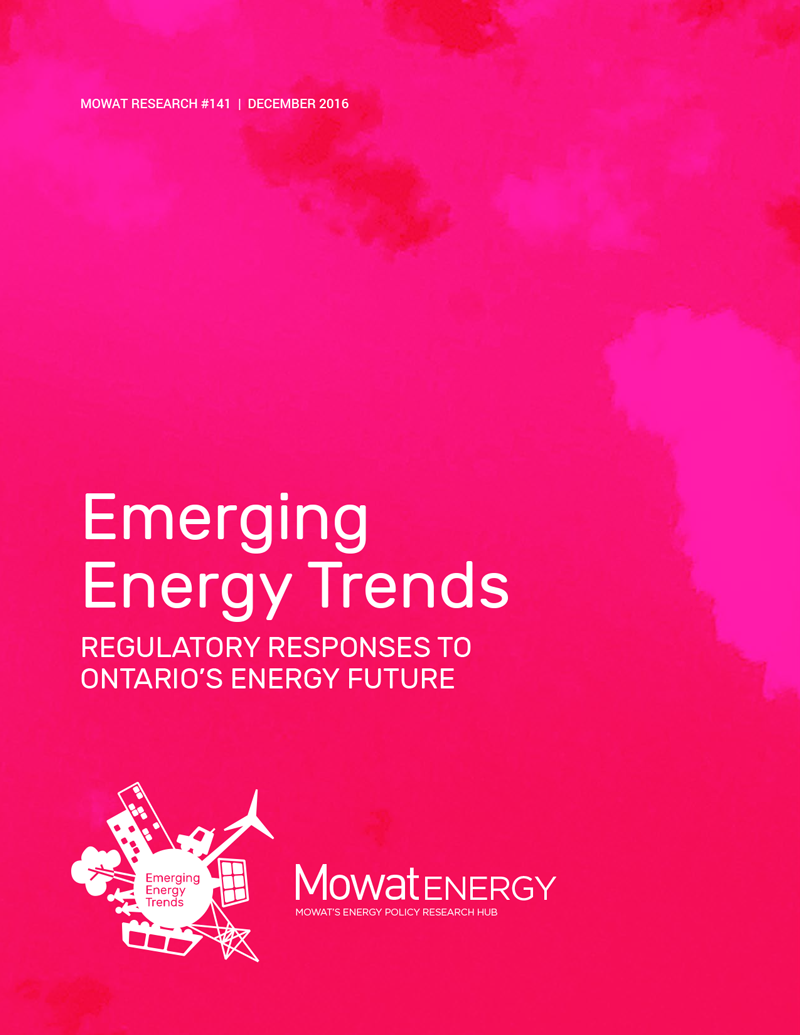December 20, 2016
Regulatory Responses to Ontario’s Energy Future
This report identifies regulatory and policy responses to the advent of an energy future with high levels of distributed energy resources, building on European and U.S. experience responding to this development.
The report identifies a number of regulatory principles that could help ensure a fair, transparent and durable environment where distributed energy resources can compete on their own merits, allowing for the development of a future energy system that will benefit the entire province.
Executive Summary
In spring 2016 the Mowat Centre was engaged by the Ontario Ministry of Energy to commission international research on the role of distributed energy resources (DER) in energy distribution systems. After an international competition, Mowat selected acknowledged experts from Germany, the U.K., Scandinavia and the United States. As part of the project we also commissioned a very broad literature review, the purpose of which was to capture the voluminous scholarly work on this subject.
This report analyzes the international work and provides our observations on the possible Ontario responses to the DER phenomenon.
DERs are generation, storage and demand management assets typically installed behind the distribution system meter. It can also include different configurations of customers into behind-the-meter microgrids. It includes small-scale generation such as wind, combined heat and power or electric vehicles.
In some jurisdictions the deployment of DERs, such as small-scale solar, has increased rapidly in recent years, often driven by incentives. The cost of some of these technologies has decreased in recent years.
In light of these developments, and the potentially revolutionary nature of the changes, we suggest that the transition should be governed through well-established economic regulatory principles. In this way the pace of, and the genuine economic effectiveness of, this transition can be responsibly accommodated, according to principled and transparent processes. Rate treatment should rest upon economic principles.
Continue Reading
From the research we found that properly integrating DERs could certainly provide value to the energy system, especially if the DER assets are deployed in specific locations. The research points to three crucial areas of interest when preparing for this transition:
- bottom-up regional planning process
- utility regulation and business model
- DER ratemaking.
Our paper suggests that the crucial first step in the appropriate accommodation of DERs into the energy distribution system is an enhanced regional planning process in Ontario, building on the current regional planning process. By engaging all relevant stakeholders in a transparent process, the true system value of DER deployments can be ascertained, and alternative sources of supply properly evaluated.
A fair, transparent and durable environment where DERs can compete on their own merits will allow for the development of an energy system that will benefit the entire province.
As to utility regulation and business model considerations, there is a threat that material defection of load from distribution systems can have serious impacts on the system, the utilities and the respective rate classes. While some have posited that “freeing” utilities from the shackles of regulation is the answer, others argue that what is needed is an architecture that imposes some species of legacy obligation for defecting customers, arrived at through predictable processes and based on economic analysis. In this way the utility and its customers are protected from the effects of non-economic load defection.
DERs, if properly integrated, have the potential to provide numerous benefits to all utility customers, in addition to the developer. Developing appropriate rates that accurately price the cost and benefits of DERs to the system is necessary. It will also be necessary to move beyond simple flat feed-in tariffs or net energy metering to develop new sophisticated rate designs that take into account:
- location
- system services
- ancillary services
- avoided energy or infrastructure costs.
A fair, transparent and durable environment where DERs can compete on their own merits will allow for the development of an energy system that will benefit the entire province.
Authors
Paul Sommerville
Richard Carlson
Petar Prazic
Release Date
December 2016
ISBN
978-1-77259-029-6
Mowat Research
No. 141

Emerging Energy Trends is a comprehensive study of how technological and consumer disruptions in the energy sector could affect Ontario and beyond.
To the Emerging Energy Trends pageOther Emerging Energy Trends papers
Background Report on the Ontario Energy Sector
Future Drivers and Trends Affecting Energy Development in Ontario: THE FUTURE OF ELECTRICITY SUPPLY
Future Drivers and Trends Affecting Energy Development in Ontario: LESSONS LEARNED FROM THE U.S.
Future Drivers and Trends Affecting Energy Development in Ontario: LESSONS LEARNED FROM SWEDEN
Future Drivers and Trends Affecting Energy Development in Ontario: A LITERATURE REVIEW








